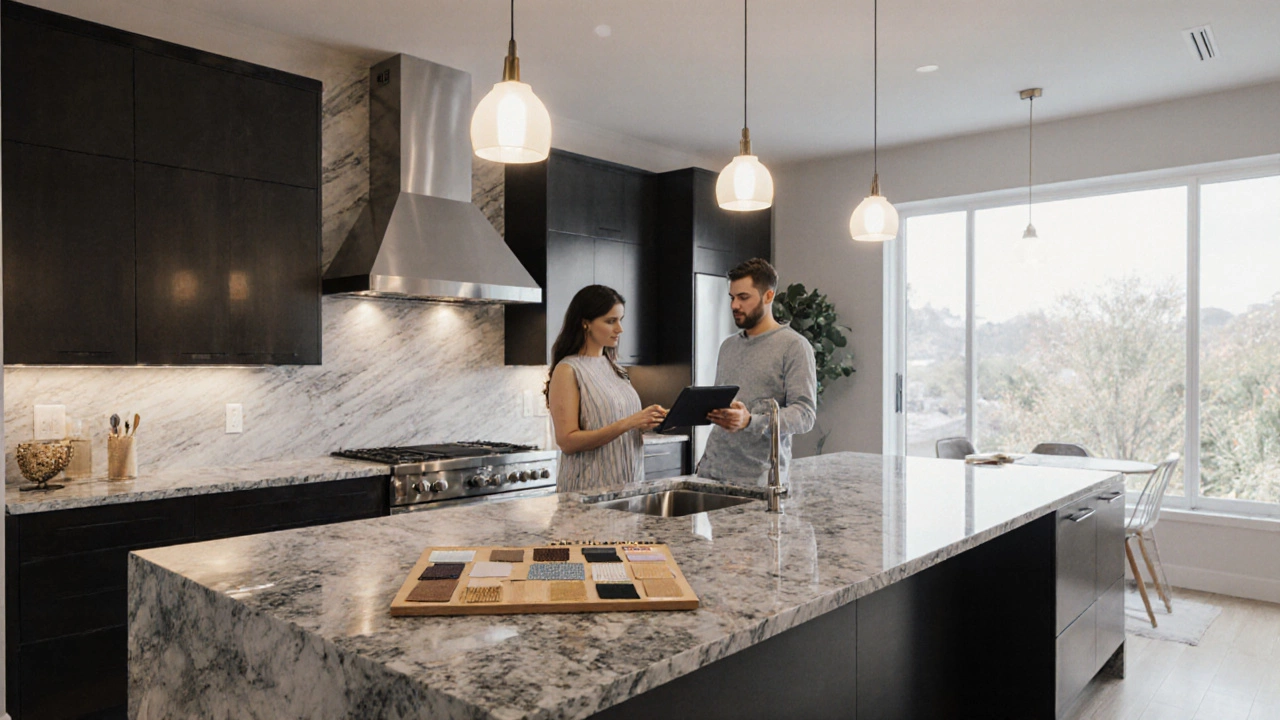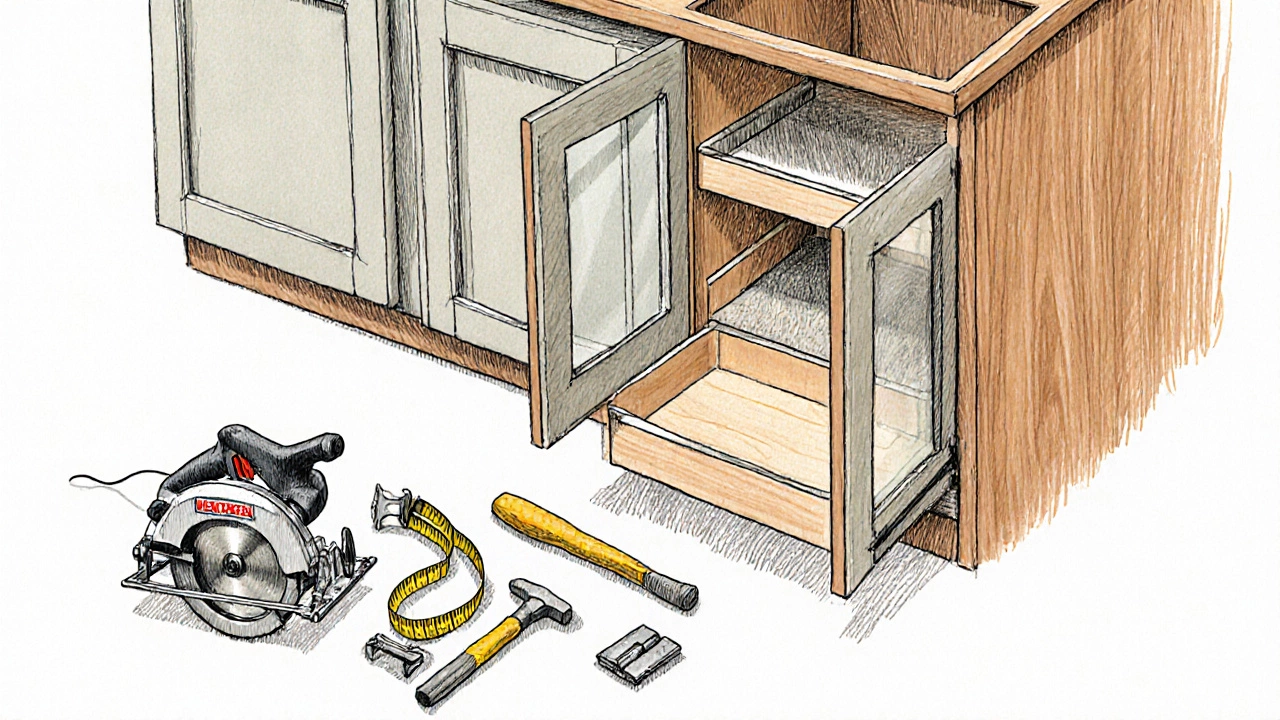What Is the Most Expensive Part of a Kitchen Remodel? Uncover the Cost Drivers
 Oct, 25 2025
Oct, 25 2025
Kitchen Remodel Budget Calculator
Your Total Budget
Cost Distribution
Cabinetry: ($ - $)
Countertops: ($ - $)
Appliances: ($ - $)
Flooring: ($ - $)
Plumbing & Electrical: ($ - $)
Labor: ($ - $)
Permits & Overhead: ($ - $)
Pro Tip: The article shows that cabinetry is typically the most expensive component, accounting for 30-35% of your total budget.
When you start planning a kitchen remodel, the first thing that pops into most people’s heads is a glossy photo of a brand‑new island and shiny appliances. But when the final invoice arrives, many homeowners gasp at the number and wonder where the money vanished. The truth is, one component routinely swallows the biggest slice of the budget. In this guide we’ll break down every major cost area, highlight the true cost‑monster, and give you practical ways to keep the bill from blowing out.
Key Takeaways
- High‑end cabinets typically account for 30‑35% of a kitchen remodel budget, making them the most expensive part.
- Countertops, appliances, flooring, and trade labor follow, each consuming 10‑20% of total costs.
- Smart material choices, modular designs, and careful layout planning can trim cabinet costs by up to 25%.
- Hidden expenses-permits, waste disposal, and unforeseen plumbing adjustments-add 5‑10% to the final price.
- Using the comparison table below helps you see where every dollar goes before you sign any contract.
Understanding the Whole‑Project Budget
Before we pinpoint the most expensive element, it helps to see the remodel as a collection of linked pieces. Each piece carries three aspects: material cost, labor cost, and overhead (permits, design fees, waste removal). The sum of these three across all components forms your final price.
Major Cost Components
Below is a quick snapshot of the typical cost distribution for a mid‑range kitchen renovation in 2025 (based on data from the New Zealand Home Builders Association and a 2024 Australian remodeling study).
| Component | Typical % of Total | Typical Cost (NZD) |
|---|---|---|
| Cabinetry | 30‑35% | $13,500‑$15,750 |
| Countertops | 10‑15% | $4,500‑$6,750 |
| Appliances | 12‑18% | $5,400‑$8,100 |
| Flooring | 7‑12% | $3,150‑$5,400 |
| Plumbing & Electrical | 8‑12% | $3,600‑$5,400 |
| Labor (general) | 15‑20% | $6,750‑$9,000 |
| Permits & Overhead | 5‑8% | $2,250‑$3,600 |
The Real Cost‑Monster: Cabinetry
Cabinetry is the storage infrastructure of a kitchen, typically built from wood, plywood, MDF, or engineered composites and finished with veneer, paint, or laminate. It accounts for roughly a third of the total remodel spend, making it the most expensive part of a kitchen remodel.
Why do cabinets chew up so much money? Three main reasons:
- Material cost. Premium hardwoods (e.g., walnut, cherry) can cost $200‑$300 per linear foot, while engineered options sit around $80‑$150.
- Labor intensity. Every cabinet requires precise cutting, joinery, finish sanding, and often custom hardware installation. Carpenters typically charge $50‑$80 per hour, and a standard 30‑cabinet kitchen can demand 100‑150 labor hours.
- Customization. Full‑height islands, glass‑front doors, soft‑close hinges, and decorative molding add both material and labor premiums.

How to Trim Cabinet Costs Without Sacrificing Style
Even though cabinets dominate the budget, you can still keep them under control. Here are five proven tactics:
- Choose stock or semi‑custom options. Stock cabinets are pre‑built in standard sizes and usually cost 40‑60% less than fully custom units.
- Opt for engineered wood. High‑quality MDF or plywood with a durable veneer can mimic the look of solid wood at a fraction of the price.
- Limit glass doors. Glass inserts boost both material cost and labor; a simple solid panel finish saves up to $1,200 on a 30‑cabinet layout.
- Standardize dimensions. Sticking to 12‑inch depth and 24‑inch height modules reduces waste and cuts fabrication time.
- Shop sales and negotiate. Many suppliers run end‑of‑season clearance sales; securing a 10‑15% discount on cabinet packages is common if you time your purchase right.
Other High‑Cost Items to Watch
While cabinetry leads the pack, several other components can surprise you if you don’t plan ahead.
Countertops include a wide price range-from $80 per square foot for laminate to $250+ for quartz or marble. Choosing exotic stone, custom edge profiles, and full‑height backsplashes can push countertop expenses beyond $10,000.
Appliances (fridge, oven, cooktop, dishwasher) represent roughly 12‑18% of the budget. High‑end brands with smart connectivity can cost double the mid‑range models.
Flooring options such as engineered hardwood, natural stone, or luxury vinyl tile range from $70 to $200 per square meter installed. Heavy materials may also increase labor due to subfloor preparation.
Plumbing & Electrical work, especially when moving major lines, can quickly rise to $5,000‑$8,000. Hidden behind‑wall repairs, code upgrades, and venting requirements often add unexpected costs.
Labor, Permits, and Hidden Fees
Labor isn’t just the carpenter; electricians, plumbers, tile installers, and project managers each bill their own rates. In Wellington, the average hourly rates in 2025 are:
- Carpenter: $55‑$75
- Electrician: $70‑$90
- Plumber: $68‑$88
- Tile installer: $60‑$80
Permits for structural changes or gas line modifications can add $800‑$1,500. Waste removal, temporary kitchen setups, and design consulting each tack on a few thousand more.
Budgeting Tips to Keep the Entire Project on Track
- Start with a solid cost model. Use the table above as a baseline and adjust percentages based on your design preferences.
- Allocate a 10% contingency. This buffer absorbs surprises like hidden water damage or code upgrades.
- Get multiple quotes. For each trade (cabinetry, flooring, plumbing), obtain at least three written estimates and compare line‑item details.
- Phase the remodel. If budget is tight, tackle cabinets first, then add countertops later. Phased work spreads expense over time.
- Consider DIY where feasible. Demolition, painting, or installing hardware can be done by motivated homeowners, saving up to $3,000.
Decision‑Making Matrix: When to Splurge vs. Save
Not every kitchen needs a marble island. Use the following quick matrix to decide where to allocate premium dollars.
- High‑traffic zones (working triangle). Invest in durable countertops and reliable appliances.
- Visual focal points (island, backsplash). If it’s the room’s centerpiece, consider higher‑end materials.
- Storage needs. Custom cabinet interiors (pull‑out shelves, spice racks) add functionality without major cost spikes.
- Future resale. Mid‑range cabinets and neutral countertops tend to please most buyers and yield better ROI.
Bottom Line
If you’re budgeting for a kitchen remodel, expect cabinetry to take the biggest bite out of your wallet. By understanding why cabinets cost so much and applying smart cost‑cutting strategies, you can keep the overall spend within your target range while still achieving a beautiful, functional space.
Frequently Asked Questions
What percentage of a kitchen remodel budget typically goes to cabinets?
Cabinets usually consume 30‑35% of the total remodel cost, making them the largest single expense.
Can I use stock cabinets to stay under budget?
Yes. Stock or semi‑custom cabinets can cost 40‑60% less than fully custom units, and many homeowners find them plenty stylish for a mid‑range remodel.
How much do high‑end countertops add to the overall price?
Premium quartz or marble can run $200‑$300 per square foot installed, potentially adding $8,000‑$12,000 to a 15‑square‑meter kitchen.
Are permits required for all kitchen remodels?
If you move plumbing, gas lines, or structural walls, most councils-including Wellington City Council-require permits, typically costing $800‑$1,500.
What’s a realistic contingency amount?
A 10% contingency of the total budget is a common rule of thumb to cover hidden issues or design changes.
